Oscillations of Artistic Life: Studies of Synchronism
Studies of periodical processes in the aesthetic sphere started from cyclic behavior of art STYLE (Maslov, 1983; Martindale, 1990; Koshkin, 1997; Petrov, 2001), and then turned to the INTENSITY of artistic life (Kharuto, Mazul, & Petrov, 2000; Petrov & Mazhul, 2002; Kulichkin, 2004; Kovalenko, 2006). So the problem arose dealing with RELATIONSHIPS BETWEEN OSCILLATIONS OF INTENSITY in different spheres. We realized a comparison of ‘fast processes' in music and painting (Russia and West Europe, 15th - 20th centuries).
Intensity of artistic life: raw materials and procedures of comparison
To measure the evolution of the intensity of artistic life, the data on 5180 composers and 610 painters were used, borrowed from two special encyclopedias devoted to music and fine arts, respectively. [At the preliminary stage of the investigation, different encyclopedias were compared with each other, in order to corroborate the ‘objectivity' of the two sources chosen - see Petrov & Mazhul, 2002.] Each primary 10-year segment of the evolution was estimated by its ‘weight' in the encyclopedia chosen. This ‘weight' (or intensity of the artistic life concerning the given kind of art) was measured as the NUMBER OF LINES devoted to those creative persons which were born during these ten years. Appropriate evolutionary dependences were built (Kulichkin, 2004); each of them consisted of TWO CONSTITUENTS:
- hill-like long-range trend (artifact caused by the procedures of compiling the encyclopedias: the decline of the interest to remote epochs, and uncertainty of current events);
- short-range
‘fast processes' against the above hill-like background.
Exactly these FAST OSCILLATIONS were of most interest for the given investigation.
To COMPARE each pair of the evolutionary dependences, it was necessary, firstly, to eliminate the impact of their long-range trends. To do this, each trend was described with the help of a trend line (polynomial), and appropriate values were subtracted from the raw data. Secondly, it was desirable to suppress ‘too fast' oscillations commensurable with the size of primary temporal segments used; this task was solved by means of ‘smoothing' (low-frequency filtration) of each curve. These procedures were realized with the help of a special COMPUTER PROGRAM: ‘Waves_Ex' (Waves Examination) derived by Dr. Alexander Kharuto.
In the given investigation, rather ‘aggregated' results are presented relating to such large cultural regions as Russia and West Europe (based on the data for different countries).
Comparing the processes within each given cultural region
A typical example of raw data used is presented by Fig. 1: evolutionary curves for RUSSIAN MUSIC AND RUSSIAN PAINTING.
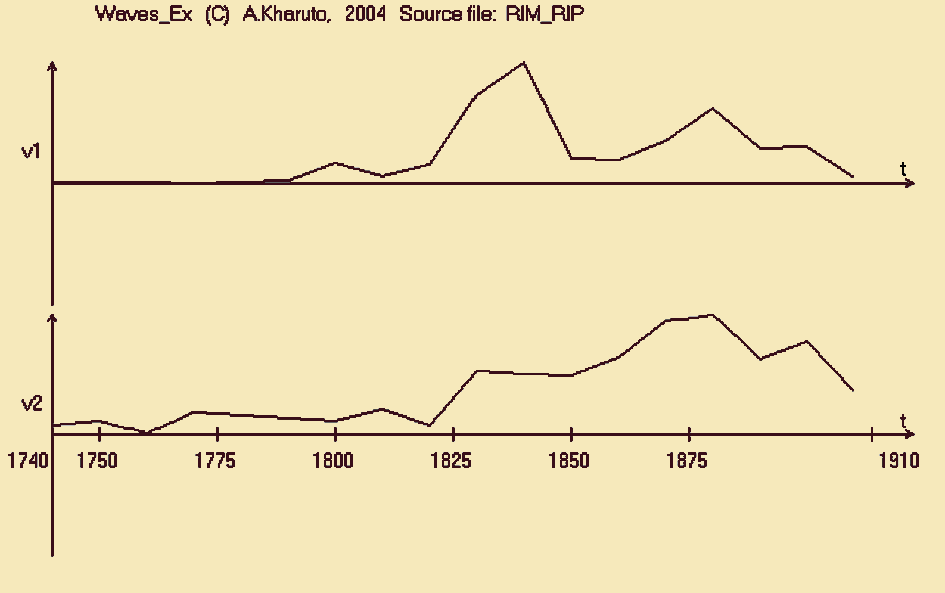 |
|
Figure 1. Two evolutionary dependences to be compared: Russian music and painting
|
The long-range trends inherent in each of these curves were approximated (for the temporal diapason from 1740 till 1910, where the comparison is possible) by straight lines. After subtracting the values responding to these linear approximations from the above raw data, and the ‘smoothing' by means of the triangle-form ‘weight function' (with the 5-point basis, effective width about 37 years), we come to Fig. 2.
Mutual correlation between these two curves is shown by Fig. 3. This correlation is calculated on the data relating to 15 temporal segments (points of comparison), hence the results obtained seem to be rather reliable.
We see the maximal absolute value of the correlation (+0.71) when the first curve ‘outstrips' the second curve on 40 years. It means that firstly the changes in musical life take place, followed (after 40 years) by the changes in painting.
Analogous calculations were made in application to WEST-EUROPEAN MUSIC AND PAINTING. Fig. 4 shows the resulting (‘smoothed') evolutionary curves for these two kinds of the intensity (for their long-range linear trends, time diapason from 1440 to 1910 - in total 48 points of comparison). For these curves, the maximum correlation (+0.50 - see Fig. 5) relates to 60-year outstripping of musical curve.
[Negative correlation peak is explained by periodicity of both curves.]
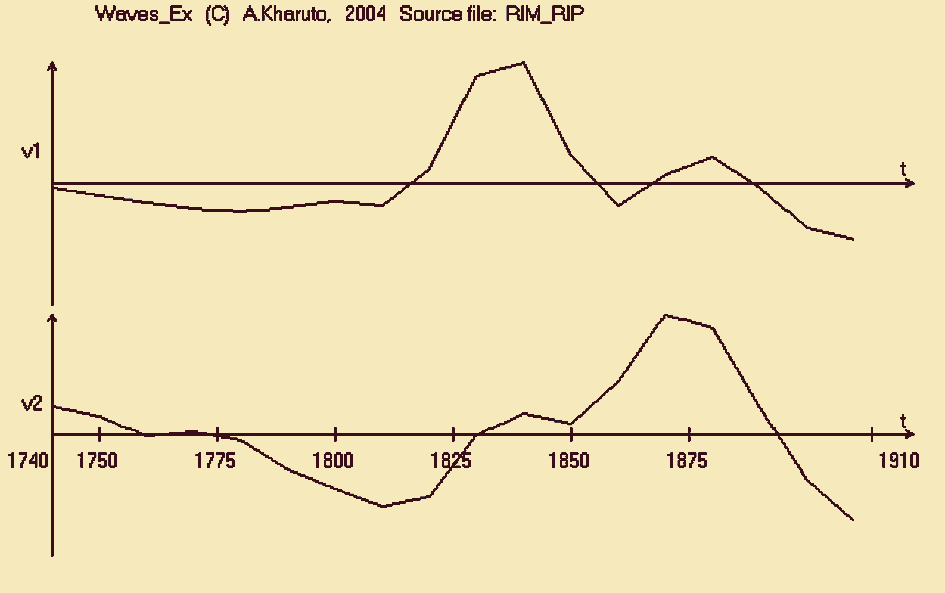
|
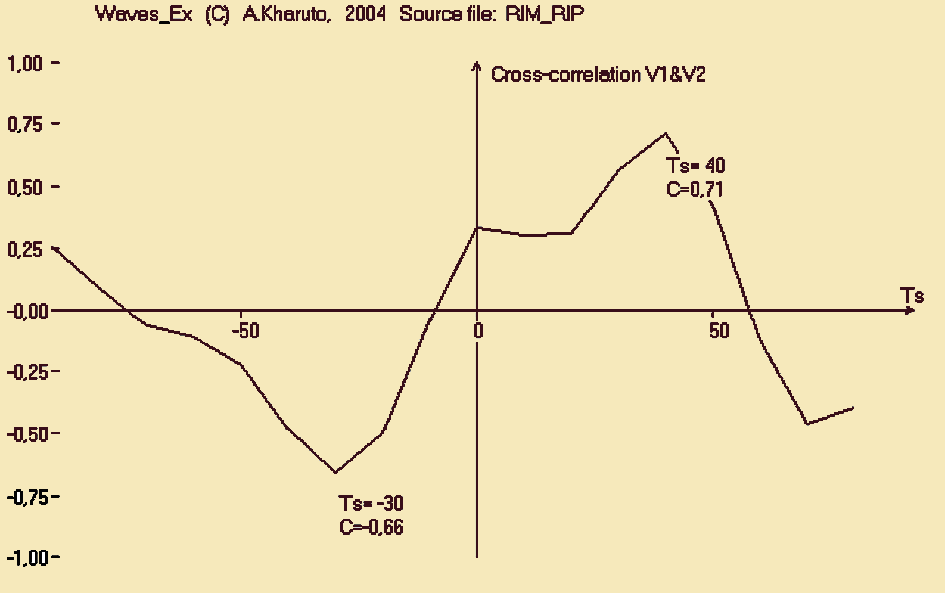
|
|
Figure 2. The same dependences after subtracting their long-range trends and ‘smoothing' |
Figure 3. Mutual correlation between Russian music and painting |
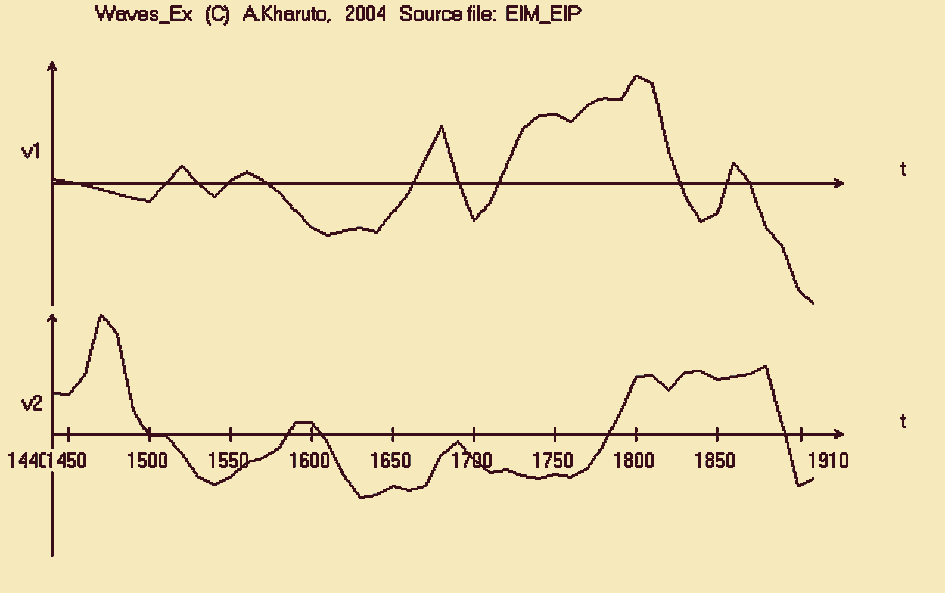
|

|
| Figure 4. ‘Smoothed' evolutionary dependences for West-European music and painting | Figure 5. Mutual correlation between West-European music and painting |
Comparing different cultural regions
Fig. 6 presents the raw evolutionary curves concerning RUSSIAN AND WEST-EUROPEAN MUSIC. The same dependences after subtracting their long-range (linear) trends and ‘smoothing' are shown by Fig. 7.

|

|
| Figure 6. Two evolutionary curves to be compared: Russian and West-European music | Figure 7. The same evolutionary curves after subtracting their long-range trends and ‘smoothing' |

|
|
Figure 8. The mutual correlation between Russian and West-European music |
The mutual correlation between the intensity of Russian (upper curve) and West-European music is presented by Fig. 8. Here we see the West-European musical life ‘outstripping' Russian musical life on about 30 years (maximal correlation +0.52, based on 15 points of comparison).
Analogous calculations for RUSSIAN AND WEST-EUROPEAN PAINTING came to the results shown on Fig. 9 (source curves) and Fig. 10 (mutual correlation). Here we see about 50-year ‘outstripping' of West-European painting, with the correlation equal to +0.48 (based on 15 points of comparison). The last result is in good agreement with our previous data concerning LONG-RANGE TRENDS IN STYLE of French painting and Russian one (the stylistic features of painting were measured in relation to left- or right-hemispheric prevalence in the creativity of painters): main stylistic indicators of Russian painting simply ‘followed' the evolution of French painting, with a delay of about 50 years (Gribkov & Petrov, 1997).
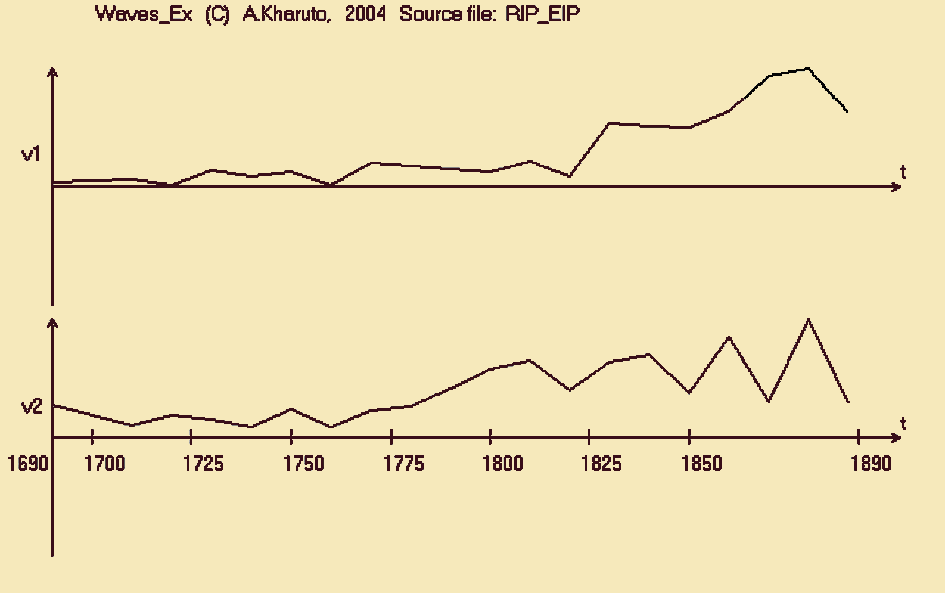
|
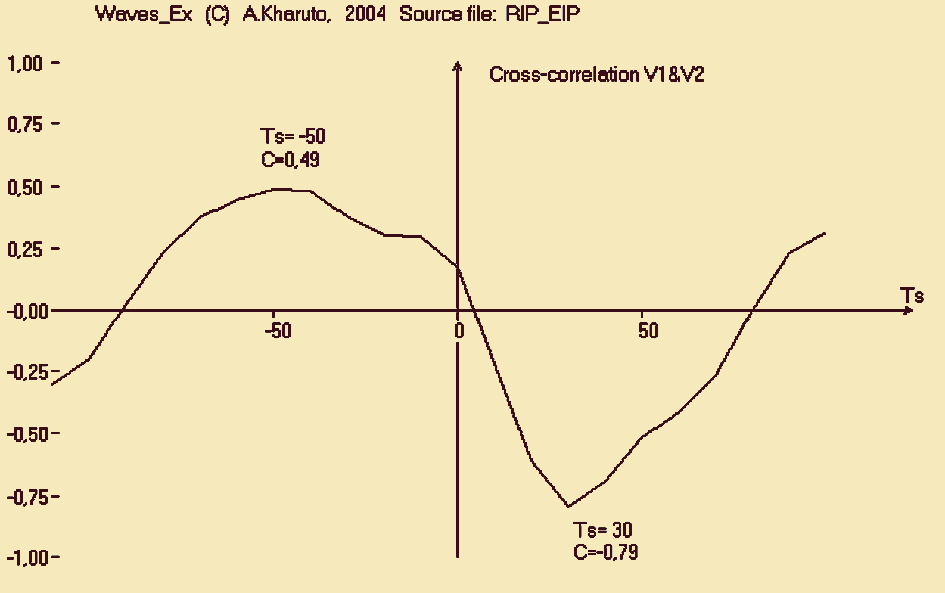
|
| Figure 9. Two evolutionary curves to be compared: Russian and West-European painting | Figure 10. The mutual correlation between Russian and West-European painting |
The totality of the results obtained evidences in favor of rather TIGHT CORRELATION in the world of the evolutionary regularities (in agreement with the informational concept of coordinated evolution of different cultural branches - Maslov, 1983). This correlation concerns both the SYNCHRONISM between different KINDS OF ACTIVITY within each cultural region and CROSS-CULTURAL INTERACTIONS.
References
Gribkov, V.S., & Petrov, V.M. (1997). Hemispherical asymmetry in creativity: Long-range trend in painting. In V.P.Ryzhov (Ed.), Empirical aesthetics: information approach (pp. 125-133). Taganrog: Taganrog State University of Radio Engineering.
Kharuto, A.V., Mazhul, L.A., & Petrov, V.M. (2000). Cyclic literary life in Russia: prose of the 18th-20th centuries (Information approach). In V.M.Petrov & V.P.Ryzhov (Eds.), Information approach in the human science: Proceedings of the International Symposium (pp. 163-165). Taganrog: Taganrog State University of Radio Engineering.
Koshkin, V.M. (1997). Etudes on a science of humanities. In L.Dorfman, C.Martindale, D.Leontiev, G.Cupchik, V.Petrov, & P.Machotka (Eds.), Emotion, creativity, and art. Vol. 1 (pp. 155-177). Perm: Perm State Institute of Arts and Culture.
Kovalenko, T. (2006). Theatrical life in Russia, 18th - 20th centuries: Measurement of intensity. This issue.
Kulichkin, P.A. (2004). Evolution of artistic life: Russian literature and Russian music in the 19th century (quantitative approach). In J.P.Frois, P.Andrade, & J.F.Marques (Eds.), Art and science: Proceedings of the 18th Congress of the International Association of Empirical Aesthetics (pp. 112-115). Lisboa: Calouste Gulbenkian Foundation.
Martindale, C. (1990). The clockwork muse: The predictability of artistic change. New York: Basic Books.
Maslov, S.Yu. (1983). Asymmetry of cognitive processes and its consequences. Semiotika i Informatika, 20, 3-34 (in Russian).
Petrov, V.M. (2001). Creativity in art: Stylistic waves and monotonous evolutionary trends (Information approach). Bulletin of Psychology and the Arts, 2 (1), 30-33.
Petrov, V.M., & Mazhul, L.A. (2002). Pulsation of literary life: periodical behavior of Russian poetry and prose in light of the information approach. Rivista di Psicologia dell'Arte, 13, 25-40.